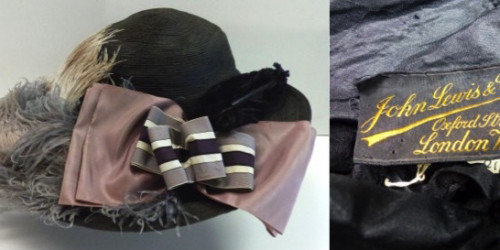
Conservation of Hats Through an Intern’s Eyes by Emma Hartikka
Whodunnit – Labels as Clues to the Past
When working with historical objects, you quickly become interested in the aspects hiding behind the purely tangible features such as materials, structure, technique, colors, style and damages. This is the case even with the 21 Worthing hats. You start to ask them various questions: who made you, dear hat? When and where? What meaning did you have to the person wearing you or to the others seeing you to be worn? All the little material details mentioned above can give valuable insight into these questions, into a hat’s past. Often you need to do some reading between the lines but, if you are lucky, just reading the lines straight out will go a long way.
You see, there is one immensely helpful clue that offers an eager hats investigator a shortcut in trying to answer some of the arising questions – a label or a maker’s mark. Nine (almost half of the twenty-one hats) have a label either stitched or stamped on. I decided to take a closer look at the labels to see what they could tell us. In order to get some extra bits and pieces of information on the various labels found on the Worthing hats, I also delved into the depths of the Internet.
It turns out that at least six of the nine labeled hats originated from London based shops. Especially Oxford Street seems to have been quite a popular place to do some headwear shopping. Two prominent London department stores are featured, Marshall & Snelgrove (opened in Oxford Street as a smaller shop in 1837 and now under the name Debenhams) and John Lewis & Co. (opened in Oxford Street in 1864 as a draper’s shop), both of which are still running in one form or another. According to the labels, three of the remaining four hats are from other parts of England, one from Malvern, Worcestershire, one from Watford and one from Brighton. Only one of the labels had no mention of the hat’s city of origin.


As a temporary Brightonian, the label James and Cubison, 64 East Street, Brighton holds a special interest for me. It belongs to a grey straw bonnet, dated to c. 1880-85 in the museum records. Surfing through the Internet, I found a blog called London Street Views and there a blog post about the person possibly behind the Brighton hat, written by Baldwin Hamey. According to Hamey’s sources, Richard Cubison had a straw hat manufacturing business in Oxford Street, London in the early 19th century. After his death in 1820’s the business was continued by his widow with a business partner Mrs. James and later by his two daughters Lydia and Charlotte Louisa as milliners and straw bonnet makers until the year 1872. Hamey states that from 1867 James and Cubison seemed to have a branch shop also at 64 East Street Brighton, which is actually very near the seafront. I can just imagine how straw hats would have been in hot demand on a sunny summer day on Brighton Beach!

The Internet is a nice starting point when investigating the labels but can only be a starting point. More serious and thorough research would certainly need other sources to draw from. This might reveal also the secrets of those labels about which the Internet stayed silent. One interesting example of a label not found online is stamped on a pink motoring hat (possible dating in the museum records c. 1917-18). The stamp has a picture of a calf and the globe in the background. The inscription says: The “Calf” Make Trade Mark.
Another intriguing mystery label belongs to a straw bonnet, possibly dating to c. 1870-80. The label has an inscription King Bros from Whiteley’s, Westow Hill, Upper Norwood and the royal coat of arms of the United Kingdom. What is the story behind these particular hats and their labels?
The subject of labels found inside of the hats would offer me a great excuse (a donkey’s bridge as we say in Finnish) to say a word about the conservation of the linings as well. However, I decided to give some mercy to you, my dear reader, and leave the issue for another blog post. Therefore, to be continued…
Sources:





How nice that you can confirm that James & Cubison indeed did trade from Brighton. When writing the post for my Street View blog, I could not find any proof that they had a second shop in Brighton, so well done to you. I have linked back to your post.
Regards,
Baldwin